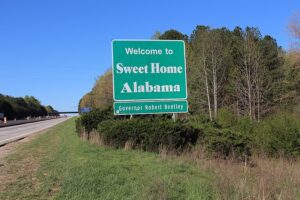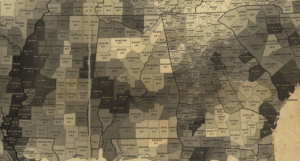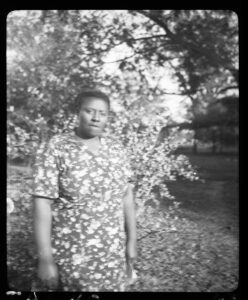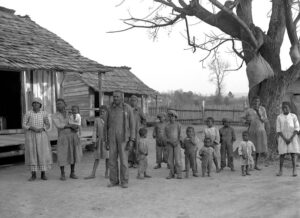Cover: Postcard of a roadside Alabama welcome billboard c. 1950s. Public Domain.
The present-day town of Cuba was first built on the backs of enslaved African-Americans back in the mid-nineteenth century. In fact, when Mr. R.A. Clay arrived here with 100 slaves and bought the land in 1852, though the place had its own post office, it had little else besides an abundance of wilderness. Nonetheless, Clay had his slaves clear out the forests of oak and hickory, and by 1861, the area was a blossoming farmland of truck crops.

During that period, Clay donated land to the Southern Railroad even going as far as to have his enslaved workers help build the railroad’s right-of-way. The area soon became known as Cuba Station, and Mr. Clay’s land started turning into a small town.
In 1870, Clay would sell half of his fledgling town to a Mr. Warner Lewis who divided his part into lots, two of which he reserved for a Baptist Church and Methodist Church. The Baptist Church still stands today.
By 1880, 232 people lived in Cuba Station. In 1890, the town became incorporated and shortened its name to simply Cuba. Thirty years later, the town had reached its peak population of 719 in 1920. A hundred years later, the 2020 census showed the population of Cuba had dropped to around 300 people.
Today, the town is mostly a pit-stop for truckers, family vacationers, road trippers, and the like traveling along I-59/I-20. What’s more, about a mile-and-a-half east of the Mississippi/Alabama state line at Exit 1, you’ll find a Stuckey’s Express. Located inside the Cuba One Stop, pick up all of your favorite road trip snacks like our iconic Stuckey’s Pecan Log Rolls, classic Pecan Pralines, and more.
And once you’ve had your fill of relaxing, refreshing, and refueling, why not check out these things to see and do while you’re in the area?
Black Belt Museum / Livingston, AL

If you’ve driven this far hoping that you’ll see displays of martial arts champions and celebrities like Bruce Lee, Jackie Chan, and Chuck Norris or learn the world’s deadliest fighting secrets from Count Dante, well, we’re afraid you’ll be leaving thinking this place is a bunch of Hong Kong phooey.
Rather, the “Black Belt” in this museum refers to both a geological and a sociological region of the southern United States. The geographical Black Belt is the somewhat crescent-shaped area of dark fertile soil that’s about 300 miles long and up to 25 miles wide located mostly in central Alabama and northeast Mississippi. In the early 19th century, settlers to the area found the soil was great for growing cotton which brings us to the sociological reason it’s called the Black Belt.
That land was only profitable because of the slaves who were brought in large numbers to pick cotton and other crops grown there. After the Civil War, the term became a political one and was used to show the counties where there were more Blacks than Whites.
The Black Belt Museum, located near the Sumter County Courthouse Square in the University of West Alabama’s Land Hall, works to preserve and celebrate the history and culture of the Black Belt. Inside the museum, you’ll be able to trace the history of the Black Belt area between Alabama and Mississippi through exhibits containing artifacts, photographs and documents about the both the geographical and sociological area known as the Black Belt. There are also various dinosaur fossils as well, including the skull of mosasaur which is sure to thrill your young paleontologists. For more information on hours and admission fees, visit their website here or contact the museum at +1 205 652 3828 or via email at blackbeltmuseum@uwa.edu.
Vera Hall Monument / Livingston, AL
Located just outside of the Black Belt Museum in Livingston is the Vera Hall Monument.

Born in 1902 just outside of Livingston in Payneville, Adele “Vera” Hall first got noticed for her singing while attending nearby Old Shiloh Baptist Church. It was there she met another folksinger and storyteller named Rich Amerson who became her mentor, teaching her an eclectic collection of Blues and folk songs.
Later in her life, she would meet Willie Ward, her second husband. The two would often go down to the Tin Cup area of Livingston and frequent the juke joints there. It is believed that this is where she expanded her repertoire of songs to include the modern Blues and railroad songs.
After being discovered by ethnomusicologist John Lomax who was traveling the south recording artist for the Library of Congress, Vera (along with her cousin Dock Reed) recorded several songs for him in 1937. These included “Mourin’ Song”, “Oh, Jesus, Jes’ Write My Name”, “Another Man Done Gone“, “Wild Ox Moan”. When Lomax released these songs to the public, Vera became one of the most sought after singers in the country. What’s more, after the British Broadcasting Company (BBC) played her song “Another Man Done Gone” on the radio in 1940, Vera became and international singing sensation.
Still, with all the fame and glory, Vera remained working as a washerwoman and cook throughout her life. She died in 1964 and was buried in Livingston Cemetery, though nobody is sure exactly where, as in the 1970s, here wooden cross was plowed over by a bulldozer. Nevertheless, on April 21 2007, the Sumter County Historical Society and Alabama Blues Project unveiled a monument to Vera who many people believe to be foremost American singer of the Blues and African-American spiritual music.

The Alabama Civil Rights Freedom Farm Museum / Eutaw, AL
A few miles north of Livingston near the town of Eutaw, you’ll find The Alabama Civil Rights Freedom Farm Museum.
The museum is a series of shotgun shacks that preserve and interpret the everyday lives of Blacks living in the South in the early to mid-twentieth century. The shacks are named for civil rights pioneers and leaders like Rosa Parks, Martin Luther King, Jr. and Ralph Abernathy. Each house also depicts a decade from the 1930s to the 1960s with artifacts, photos and other items related to the decade.
There is also a monument listing the names of local residents who also took part in the Civil Rights Movement.
There is no known website for the museum itself, but you can call them at +1-205-372-3446 for info on hours and admission.
—
Right now on our website, we’ve put a halt on all orders until February 20th as we transfer to a bigger, better warehouse so we can bring you even more delicious Stuckey’s products.
However, we just look at it as an excuse for you to take a road trip to your nearest Stuckey’s for Valentine’s Day treats, road trip snacks, and Stuckey’s branded clothing and other merchandise. (And of course, while you’re there, you might as well go ahead and pick up some kitschy souvenirs to remember your trip by.)
And you can still find your nearest Stuckey’s by visiting our store’s website located here.
In the meantime, you can also keep yourself entertained here on our Stuckey’s Pecan Blog Roll.
The 20th will be here in no time. Until then…
Stuckey’s – We’re Making Road Trips Fun Again!
Whether your next road trip is by car or by rail, it’s not really a road trip without taking Stuckey’s along. From our world famous Stuckey’s Pecan Log Rolls to our mouthwatering Hunkey Dorey, Stuckey’s has all the road trips snacks you’ll need to get you where you’re going.
For all of the pecany good treats and cool merch you’ll need for your next big road adventure, browse our online store now!
Stuckey’s – We’re Making Road Trips Fun Again!
